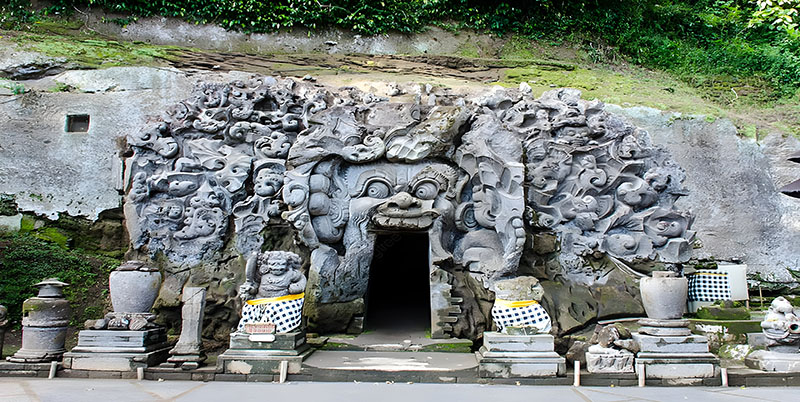Goa Gajah is an artificial cave that functions as a place of worship. This cave is located in Bedulu Village, Blahbatu District, Gianyar Regency, Bali. In the Negarakertagama palm leaf book compiled by Mpu Prapanca in 1365 AD there is the literature Lwa Gajah (Lwa or Lwah/Loh) which means elephant river. The river located in front of the temple is now known as the Petanu River.
Religious Activities at the Goa Gajah Temple Site The discovery of Goa Gajah began with a report from a Dutch East Indies official, LC. Heyting in 1923 who discovered the Ganesha, Trilingga and Hariti statues for the Dutch East Indies government. This was followed up by Dr. WF. Stuterhiem to conduct further research in 1925. In 1950 the Indonesian Antiquities Service, through the archaeological building sections in Bali, led by J.L Krijgman, conducted research and excavations from 1954 to 1979 and an ancient shrine was found with 6 statues of women with fountains. water on the chest and until now its presence can be believed to provide a vibrating aura of purification for visitors. In 1931 Mr. Conrat Spies also found quite an important relic in the "tukad pangkung" complex in the form of a three-pronged stupa carved into a collapsed stone wall lying at the bottom of the tukad pangkung.
From the data available in the field, it can be stated that the Goa Gajah site was a sacred place as a center for Hindu and Buddhist religious activities during the reign of the Warnadewa Dynasty from the X-XIV century AD. Nowadays, the Goa Gajah Temple site is a sacred place for Hinduism to worship Sang Hyang Widhi Wasa (God Almighty). Apart from that, the Goa Gajah Complex consists of 2 main parts, namely the northern complex which is a legacy of Shiva's teachings, with evidence of the Trilingga and Ganesha statues in the cave, which is where Hindus pray. The complex to the south of Goa Gajah is the Tukad Pangkung area, in the form of a Buddhist stupa in the attitude of Dhyani Buddha Amitabha consisting of 13 stupas and a 3-branched stupa carved into a large rock. Religious life is a reality of human life found throughout the history of society. The dependence of society and individuals on supernatural powers has existed since ancient times and even into modern times. This belief is believed to be true so that it becomes a religious belief or religious belief. Holding ceremonies on certain days, in one place has also been going on for a long time until modern times. Believing something to be holy or sacred is also a characteristic of religious life. Likewise, the existence of rules of life that are believed to come from God is also a characteristic of religious life. All of this shows that religious life is a universal phenomenon found in the lives of individuals and society (Koentjaraningrat, 1997: 228-229).
Based on its characteristics, the Goa Gajah Temple Site is a territorial temple and is also called Pura Kahyangan Desa. In ancient times, Kahyangan Village Temple was held by the people (krama) of the traditional village or pekraman of Bedulu Village in the area concerned. However, currently Hindu communities from outside the Bedulu Village community also carry out religious worship here. Religious worship is carried out on Hindu holidays, apart from that it is also carried out on full moon days, tilem, kajeng kliwon and on piodalan days, namely on full moon days.
The Goa Gajah Temple site has a building structure like other holy places in Bali, which has a structure of dividing the temple grounds with the Tri Mandala concept, namely nista mandala or jaba side, madia mandala or middle jaba, and main mandala or innards. Nista mandala is an area to the south of Goa Gajah Temple to carry out activities that support religious ceremonies, for example as an entertainment venue, trading place, toilet, and so on. Madia mandala is the central courtyard of the temple as a place to carry out activities to prepare equipment for carrying out ceremonies such as sewing. In the middle jaba courtyard there is a sacred/most advanced building which is a relic from the Hindu Shiva Pasupata and Hindu Shiva Siddhanta periods. The shrines at Goa Gajah Temple are Limas Catu, Limas Mujung, Pura Gedong, Pelinggih Dewi Laksmi/Betara Rambut Sedana, Pelinggih Pengaruman, Bale Gde, Bale Panjang, Bale Peselang, Wantilan, Hall for the Protection of ancient statues, and the Lightning Pond. The main mandala is the most sacred area, every person who enters this mandala must fulfill the requirements for purity such as proper dress code, not being dirty/unclean. The area inside Goa Gajah is the main mandala at the Goa Gajah Temple Site.




